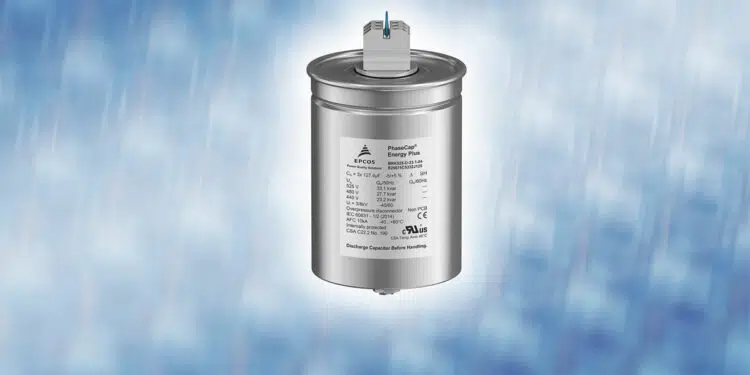TDK now offers PhaseCap Energy Plus PFC power factor correction film capacitors with significantly improved performance.
TDK Corporation introduces PhaseCap® Energy Plus, two new series of EPCOS PFC capacitors. The B25674C* series is gas-impregnated and covers a voltage range from 230 V AC to 690 V AC and offers compensation ratings from 5 kvar to 33.1 kvar, depending on the type. The B25675C* series capacitors are impregnated with a biodegradable resin and are rated for voltages from 230 V AC to 1000 V AC, with compensation ratings of up to 60 kvar.
On the basis of the well-proven film capacitors MKK-technology, this follow-on development of the PhaseCap series offers some major enhancements. These series feature an unrivaled lifetime of up to 240,000 hours in temperature class -40/D, class IP20 touch-proof terminals, and pre-mounted ceramic-based discharge resistors. They offer up to 15,000 switching operations per year, double the amount of previous types. For short periods, the series can be operated at a temperature of 60 °C, with hotspot temperatures of up to 85 °C permissible.
The robust winding design with wave-cutting technology allows the capacitors to be subjected to inrush currents equivalent to 500 times the rated current. The PhaseCap Energy Plus types are self-healing and CE and UL certified. In the event of an overload, all three phases are disconnected from the mains via an internal overpressure disconnector. The capacitors feature class IP20 touch-proof terminals and have pre-mounted ceramic-based discharge resistors.
Typical applications of the robust components are automatic PFC systems, capacitor banks, individual and group compensation, fixed and switched compensation systems as well as dynamic PFC systems.
Features
- Wide voltage range from 230 V AC to 1000 V AC
- Compensation power up to 60 kvar
- Long lifetime of up to 240,000 hours
- Integrated overpressure disconnector protection for all three phases
- Self-healing technology
- CE and UL certified
Applications
- Automatic PFC systems
- Capacitor banks
- Individual and group compensation
- Fixed and switched compensation systems
- Dynamic PFC Systems


































